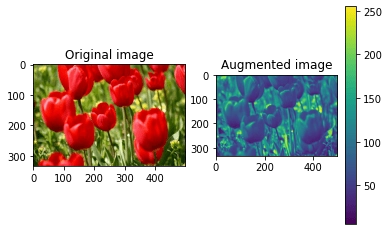Data augmentation techniques generate different versions of a real dataset artificially to increase its size. Computer vision and natural language processing (NLP) models use a data augmentation strategy to handle data scarcity and insufficient data diversity.
Data-centric AI/ML development practices, such as data augmentation, can increase the accuracy of machine learning models. According to an experiment, a deep learning model that undergoes image augmentation performs better in terms of training loss (i.e., the penalty for a bad prediction) & accuracy, as well as validation loss & accuracy, compared to a deep learning model without augmentation for the image classification task.
Data augmentation techniques in computer vision
There are geometric and color space augmentation methods for images to create image diversity in the model. It is easy to find many coding examples for these augmentation transformations from open-source libraries and articles on the topic.
Adding noise
For blurry images, adding noise to the image can be helpful. By “salt and pepper noise”, the picture appears to consist of white and black dots.
source: Medıum1
Cropping
A section of the image is selected, cropped, and then resized to the original image size.
Source: Github2
Flipping
The image is flipped horizontally and vertically. Flipping rearranges the pixels while preserving the image’s features. Vertical flipping is not meaningful for some photos, but it can be helpful in certain contexts, such as cosmology or for microscopic images. In the figure above, the first image shows the original version, while the second and third images display its horizontally and vertically flipped variants.


Source: MEDIUM[/efn_note]https://odsc.medium.com/image-augmentation-for-convolutional-neural-networks-18319e1291c[/efn_note]
Rotation
The image is rotated by an angle between 0 and 360 degrees. Every rotated image will be unique in the model.
Source: Medium3
Scaling
The image is scaled outward and inward. An object in a new image can be smaller or bigger than in the original image through scaling.
Source: Medium4
Translation
The image is shifted into various areas along the x-axis or y-axis, allowing the neural network to scan the entire picture to capture it.
Source:KDnuggets5
Brightness
The brightness of the image is changed, and the new image will be darker or lighter. This technique enables the model to recognize images under various lighting conditions.

Source: Tensorflow.org6
Contrast
The contrast of the image is altered, and the new image will differ in terms of luminance and color aspects. The contrast of the following picture is changed randomly.

Source: Tensorflow.org7
Color Augmentation
New pixel values change the color of the image. There is a grayscale example image.

Source: Tensorflow.org
Saturation
Saturation is the depth or intensity of color in an image. The following image is saturated with the data augmentation method.

Source: Tensorflow.org
You can also check our article on synthetic data for computer vision.
Data augmentation techniques in natural language models
Data augmentation techniques are applied on character, word, and text levels.
Easy Data Augmentation (EDA) Methods
EDA methods include easy text transformations, such as randomly selecting a word from a sentence and replacing it with one of its synonyms, or swapping two words in the sentence. EDA techniques examples in NLP processing are
- Synonym replacement
- Text Substitution (rule-based, ML-based, mask-based, etc.)
- Random insertion
- Random swap
- Random deletion
- Word & sentence shuffling
Back Translation
A sentence is translated into one language, and then a new sentence is translated again into the original language. So, different sentences are created.
Source: Medium8
Text Generation
A generative adversarial network (GAN) is trained to generate text with a few words.
Source: Medium9
Developers can optimize natural language models by training them on web data that contains large volumes of human speech, languages, syntaxes, and sentiments.
Data augmentation techniques for audio data
Audio data augmentation methods include cropping out a portion of data, noise injection, shifting time, speed tuning, changing pitch, mixing background noise, and masking frequency.
Source: Github10
Advanced data augmentation techniques
Advanced data augmentation methods are commonly used in the deep learning domain. Some of these techniques are
- Adversarial training
- Neural style transfer
- Generative adversarial networks (GANs) based augmentation
Data augmentation libraries
There are libraries for developers, such as Albumentations, Augmentor, Imgaug, nlpaug, NLTK, and spaCy. These libraries include geometric transformation & color space transformation functions, Kernel filters (i.e., image processing functions for sharpening and blurring), and other text transformations.
Data augmentation libraries utilize various deep learning frameworks, including Keras, MxNet, PyTorch, and TensorFlow.
If you are ready to use data augmentation in your firm, we have prepared data-driven lists of companies. However, we don’t yet have a list exclusively for data augmentation libraries. Most of the time, this functionality is provided as part of more comprehensive software packages (i.e., deep learning software):
Reference Links
Cem's work has been cited by leading global publications including Business Insider, Forbes, Washington Post, global firms like Deloitte, HPE and NGOs like World Economic Forum and supranational organizations like European Commission. You can see more reputable companies and resources that referenced AIMultiple.
Throughout his career, Cem served as a tech consultant, tech buyer and tech entrepreneur. He advised enterprises on their technology decisions at McKinsey & Company and Altman Solon for more than a decade. He also published a McKinsey report on digitalization.
He led technology strategy and procurement of a telco while reporting to the CEO. He has also led commercial growth of deep tech company Hypatos that reached a 7 digit annual recurring revenue and a 9 digit valuation from 0 within 2 years. Cem's work in Hypatos was covered by leading technology publications like TechCrunch and Business Insider.
Cem regularly speaks at international technology conferences. He graduated from Bogazici University as a computer engineer and holds an MBA from Columbia Business School.

Be the first to comment
Your email address will not be published. All fields are required.